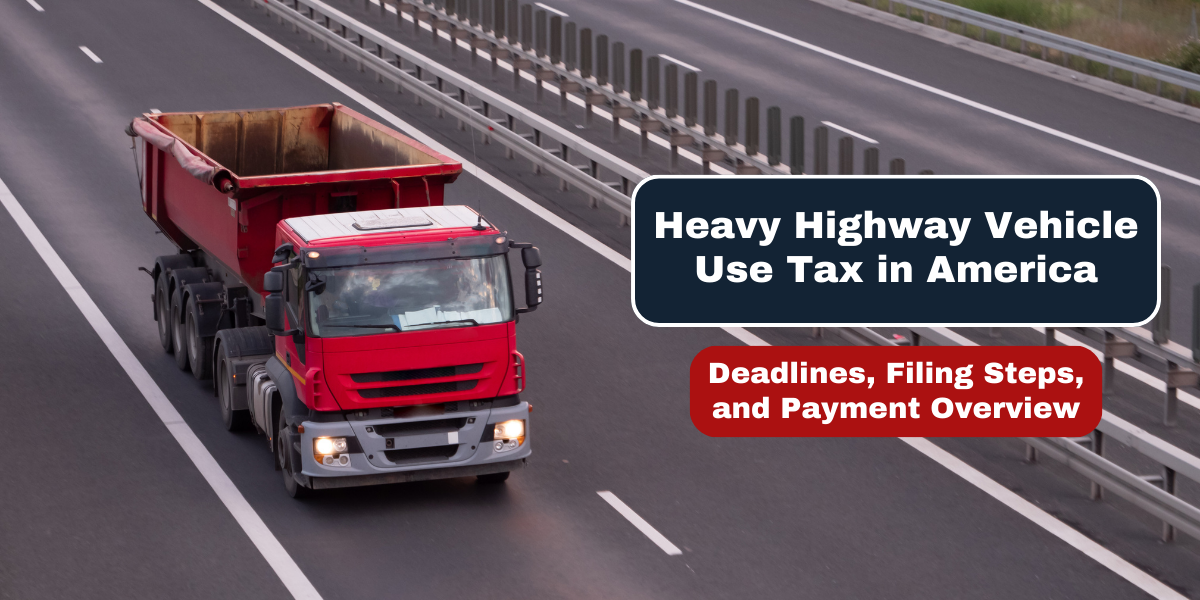The Heavy Highway Vehicle Use Tax in America is a federal excise tax applied to trucks, truck tractors, and buses that weigh 55,000 pounds or more and travel on public highways. This tax is essential for funding highway infrastructure projects, ensuring that roadways are maintained and improved for all users. Vehicle owners subject to this tax must file Form 2290 with the IRS and pay the necessary taxes by the specified deadline.
To avoid penalties and ensure compliance, it’s crucial to adhere to the IRS’s guidelines for filing and payment. Gather necessary information such as the Employer Identification Number (EIN), Vehicle Identification Number (VIN), and taxable gross weight before beginning the filing process. Timely and accurate submission will help you meet your tax obligations efficiently.
Contents
What is the Heavy Highway Vehicle Use Tax?
The Heavy Highway Vehicle Use Tax plays a critical role in supporting the maintenance and enhancement of the nation’s highway infrastructure. Applied to vehicles weighing 55,000 pounds or more, this tax ensures that those who use the roads extensively contribute to their upkeep. By funding vital infrastructure projects, it helps maintain the quality and safety of public highways for all users.
For vehicle owners, understanding this tax is essential to avoid penalties and ensure compliance with federal regulations. Properly filing and paying the tax through Form 2290 is necessary to meet obligations and support the continued improvement of highway systems. Adhering to the tax requirements helps keep the infrastructure in good condition, benefiting both drivers and the broader community.
Purpose of the Tax
The revenue from this tax helps fund federal highway projects, ensuring that roads are maintained and improved for the benefit of all road users. By paying this tax, you are contributing to the upkeep of the infrastructure you use.
Who is Affected?
The tax applies to:
- Trucks
- Truck tractors
- Buses
Each of these vehicles must meet the weight threshold to be subject to this tax. If you are a vehicle owner in this category, it is vital to stay informed about your filing obligations.
Key Deadline for Filing and Payment
Important Date: September 3, 2024
The IRS has set a critical deadline for filing Form 2290 and paying any associated taxes. For the tax year, the deadline is September 3, 2024. Missing this deadline can lead to significant penalties and interest charges.
Consequences of Missing the Deadline
- Penalties: Late fees can accumulate quickly, adding to your financial burden.
- Interest Charges: Additional interest will be applied to any overdue amounts.
- Legal Issues: Persistent non-compliance may lead to more severe consequences.
How to Comply with IRS Requirements
A. Filing Form 2290
Form 2290 is the primary document for reporting and paying the Heavy Highway Vehicle Use Tax. Here’s how to file it:
- E-File Option: The IRS requires electronic filing if you are reporting 25 or more vehicles. Even for fewer vehicles, e-filing is recommended for its convenience.
- Filing Details: Provide information about each vehicle, including its weight and usage. Accurate data is crucial to avoid issues.
Steps to E-File Form 2290
- Gather Information: Ensure you have all necessary details about your vehicles.
- Choose a Provider: Use an IRS-approved e-file provider for submission.
- Complete the Form: Fill out the form electronically and review it carefully.
- Submit: Send the completed form to the IRS through the e-filing system.
B. Payment of Taxes
Once you have filed Form 2290, you need to pay the taxes owed. The IRS accepts payments via:
- Debit Card
- Credit Card
Ensure that payments are made by the deadline to avoid penalties. The IRS does not accept other payment methods for this tax.
Payment Tips
- Verify Payment Amount: Double-check the amount due before payment.
- Use Secure Methods: Ensure that the payment process is secure to avoid fraud.
- Keep Records: Save confirmation receipts and records of your payment for future reference.
Gathering Necessary Information
Before you start the filing process, collect the following information:
I. Employer Identification Number (EIN)
You must use an EIN, not a Social Security Number (SSN), for filing Form 2290. If you don’t have one, apply for it through the IRS website.
How to Apply for an EIN
- Online Application: Apply through the IRS online portal for immediate processing.
- Complete Form SS-4: Fill out this form if applying by mail or fax.
II. Vehicle Identification Number (VIN)
Each vehicle requires its VIN for accurate reporting on Form 2290. Ensure you have the correct VIN for every vehicle you are filing for.
III. Taxable Gross Weight
Determine the taxable gross weight of each vehicle, which is the combined weight of the vehicle and its maximum load. This weight influences the amount of tax you owe.
Steps to File and Pay
A. E-Filing Form 2290
The IRS mandates e-filing for those with 25 or more vehicles, but it is also beneficial for those with fewer vehicles.
E-Filing Process
- Access the IRS e-File System: Go to the IRS website and find the e-filing portal.
- Enter Vehicle Information: Input details accurately.
- Submit Electronically: Follow the instructions to complete the filing process.
B. Paying Taxes
Payments must be made using debit or credit cards. To prevent late fines, ensure that payments are made on time.
Payment Process
- Select Payment Option: Choose debit or credit card payment.
- Confirm Amount: Verify the total amount due.
- Complete Payment: Follow the prompts to complete your payment.
Do You Need to Pay?
If you are unsure whether you need to file and pay, the IRS provides an online tool to assist you. This tool can help determine your tax obligations quickly and easily.
Using the IRS Tool
- Online Interview: Complete a brief online interview.
- Check Requirements: The tool will guide you based on your responses.
Conclusion
The deadline for the Heavy Highway Vehicle Use Tax is rapidly approaching on September 3, 2024. To avoid penalties and ensure compliance, it’s essential to start gathering the required information now. This includes your Employer Identification Number (EIN), Vehicle Identification Number (VIN), and details on the taxable gross weight of your vehicles. Filing Form 2290 and making the necessary tax payments on time will help you meet your obligations and prevent additional charges.
Being proactive and organized is key to managing your tax responsibilities effectively. By addressing these requirements promptly, you contribute to the upkeep of America’s highway infrastructure, supporting the essential maintenance and improvements that benefit all road users.
FAQs
What is the Heavy Highway Vehicle Use Tax?
The Heavy Highway Vehicle Use Tax is a federal excise tax imposed on trucks, truck tractors, and buses that weigh 55,000 pounds or more, used on public highways.
What happens if I miss the deadline to file Form 2290?
Missing the deadline can result in penalties, interest charges, and potential legal issues. It is critical to submit and pay on time to avoid these penalties.
Can I file Form 2290 using my Social Security Number?
No, you must use an Employer Identification Number (EIN) to file Form 2290. Social Security Numbers are not accepted for this tax.






